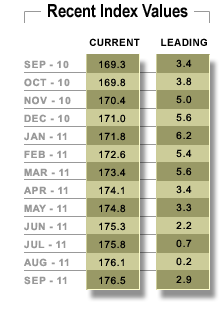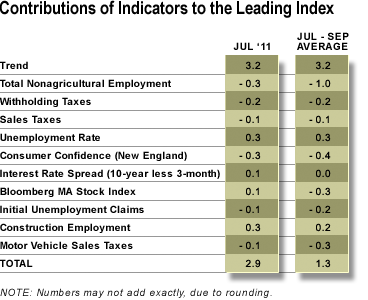State Economic Growth Continues to Outpace US in Q3, UMass Journal Reports
Global risks abound — slower growth in next two quarters is expected.
September 2011
 The real gross state product grew at an annual rate of 3.9 percent in the third quarter of 2011, according to estimates released today by MassBenchmarks, the journal of the Massachusetts economy published by the UMass Donahue Institute in collaboration with the Federal Reserve Bank of Boston. The U.S. Bureau of Economic Analysis reported today that the national economy expanded at an estimated annual rate of 2.5 percent during the same period. This follows a relatively strong second quarter, in which state output also grew faster than that of the U.S., with the state growing at an estimated 3.4 percent rate versus 1.3 percent for the nation. The state's economy has now out-performed that of the U.S. for five successive quarters.
The real gross state product grew at an annual rate of 3.9 percent in the third quarter of 2011, according to estimates released today by MassBenchmarks, the journal of the Massachusetts economy published by the UMass Donahue Institute in collaboration with the Federal Reserve Bank of Boston. The U.S. Bureau of Economic Analysis reported today that the national economy expanded at an estimated annual rate of 2.5 percent during the same period. This follows a relatively strong second quarter, in which state output also grew faster than that of the U.S., with the state growing at an estimated 3.4 percent rate versus 1.3 percent for the nation. The state's economy has now out-performed that of the U.S. for five successive quarters.
The MassBenchmarks Leading Economic Index for September was 2.9 percent, and the three-month average for July through September was 1.3 percent. The leading index is a forecast of the growth in the current index over the next six months, expressed at an annual rate. Thus, it indicates that the economy is expected to grow at an annualized rate of 2.9 percent over the next six months (through March 2012).
 The pace of expansion in economic activity in Massachusetts is slowing. Payroll employment expanded at less than a one percent annual rate in the third quarter, with net job losses reported in August and September. This follows job growth of 1.7 percent in the first quarter, and 3.1 percent in the second quarter. Income and spending growth in the third quarter also slowed, as reflected in withholding and sales taxes receipts. On a seasonally adjusted basis, withholding taxes suggest that wage and salary income declined at a 2.5 percent annual rate in the third quarter while spending on goods subject to the regular sales and automobile sales taxes grew at an anemic 0.3 percent annual rate.
The pace of expansion in economic activity in Massachusetts is slowing. Payroll employment expanded at less than a one percent annual rate in the third quarter, with net job losses reported in August and September. This follows job growth of 1.7 percent in the first quarter, and 3.1 percent in the second quarter. Income and spending growth in the third quarter also slowed, as reflected in withholding and sales taxes receipts. On a seasonally adjusted basis, withholding taxes suggest that wage and salary income declined at a 2.5 percent annual rate in the third quarter while spending on goods subject to the regular sales and automobile sales taxes grew at an anemic 0.3 percent annual rate.
Output in the third quarter was boosted by gains in productivity growth from the first two quarters of the year. This explains why the slowdown in employment and earnings in the third quarter was not fully mirrored in output.
There are indications that demand for the state's technology products, which has been a growth driver for the Commonwealth in recent quarters, may be slowing. While U.S. industrial production for information processing equipment grew robustly in the third quarter, world-wide and regional indicators of semiconductor and semiconductor equipment sales declined during the same period. Meanwhile, Massachusetts merchandise exports declined in the most recent three month period (June-August) relative to the prior three months (March-May).
"Despite the clear signs that the pace of growth has been slowing, it appears that Massachusetts — along with the nation — will continue to expand and avoid a double-dip recession," noted Dr. Alan Clayton-Matthews, MassBenchmarks Senior Contributing Editor and Associate Professor of Economics and Public Policy at Northeastern University who compiles and analyzes the Current and Leading indices.
The MassBenchmarks leading index is predicting that the state economy will grow at a 2.7 percent annual rate in the fourth quarter and at a 2.9 percent rate in the first quarter of 2012. "This suggests that while job growth can be expected, over the next six months it can be expected to be modest. Still, downside risks predominate. These include the debt crisis in Europe, the federal budget crisis in the U.S., continued high unemployment and weakness in the housing market, and the effects of these uncertainties on consumer spending and business hiring and spending," Clayton-Matthews added.
"Ongoing budget talks including those of the so called "Super Committee" are weighing heavily on the Commonwealth's economic outlook," noted Dr. Marty Romitti, MassBenchmarks Managing Editor and Director of Economic and Public Policy Research at the UMass Donahue Institute. "Federal defense contracts and research funding have been important sources of fuel for our innovation economy and have helped us to outperform the nation thus far," added Romitti.
 The 10 indicators that comprise the leading index usually do not all move in tandem. Typically, some may indicate an expectation of faster than average growth, while at the same time others may indicate an expectation of slower than average growth. The following table accounts for the contributions of each towards faster or slower growth than the long-term trend of 3.3 percent. The index value is their sum.
The 10 indicators that comprise the leading index usually do not all move in tandem. Typically, some may indicate an expectation of faster than average growth, while at the same time others may indicate an expectation of slower than average growth. The following table accounts for the contributions of each towards faster or slower growth than the long-term trend of 3.3 percent. The index value is their sum.
In September, four indicators contributed to a forecast of above-trend growth: the unemployment rate, the interest rate spread between 10 year and 3 month U.S. Treasury securities, the Bloomberg stock index for Massachusetts, and construction employment. Six indicators contributed to below-trend growth: total nonagricultural employment, withholding taxes, sales taxes, consumer confidence, initial unemployment claims, and motor vehicle sales taxes.
In the three-month period July through September, two indicators contributed to a forecast of above-trend growth: the unemployment rate, and construction employment. Seven indicators contributed to below-trend growth: total nonagricultural employment, withholding taxes, sales taxes, consumer confidence, the Bloomberg stock index for Massachusetts, initial unemployment claims, and motor vehicle sales taxes. One indicator, the interest rate spread between 10 year and 3 month U.S. Treasury securities, contributed to average-trend growth.
The current and historical quarterly estimates for state domestic product growth include adjustments for changes in productivity growth. These adjustments are estimates of the quarterly deviations from trend in the growth of the ratio of output to employment and output to wage and salary income. In the third quarter of this year, these adjustments added 0.7 percentage points to the annual rate of growth. In the second quarter of this year, these adjustments subtracted 1.8 percentage points from the annual rate of growth. For the forecast of state domestic product growth for the fourth quarter of this year and the first quarter of 2012, productivity growth is assumed to return to its long-term trend. The methodology and rationale for these adjustments are available from the author upon request.
Several recent months of the indices are revised each release. These revisions are a result of the statistical method used to create the index, as well as revisions in the underlying indicators.
--------
All of the indicators except interest rates refer to Massachusetts. The current index is composed of four indicators: nonagricultural employment, withholding taxes, sales taxes, and the unemployment rate. The leading index includes these four current indicators plus the other six (leading) indicators in the contributions table. All of the indicators are as of September, except for interest rates, and the Bloomberg stock index for Massachusetts, which are through October 24. The MassInsight Consumer Confidence Index is released every third month. Intervening months are interpolated, and changes in the Conference Board's Consumer Confidence Index for the U.S. are used to extrapolate to the current month of the index, as needed. Series measured in dollars, i.e., withholding taxes, sales taxes, the Bloomberg stock index, and motor vehicle sales taxes, are deflated by the U.S. consumer price index for all urban consumers, excluding food and energy.
For a description of the methodology used to construct these indices, see: Alan Clayton-Matthews and James H. Stock, "An application of the Stock/Watson index methodology to the Massachusetts economy", Journal of Economic and Social Measurement, vol. 25 (1998/1999), pp. 183-233.
October 27, 2011
Alan Clayton-Matthews
Senior Contributing Editor, MassBenchmarks
Associate Professor of Economics & Public Policy
School of Public Policy and Urban Affairs
Northeastern University

